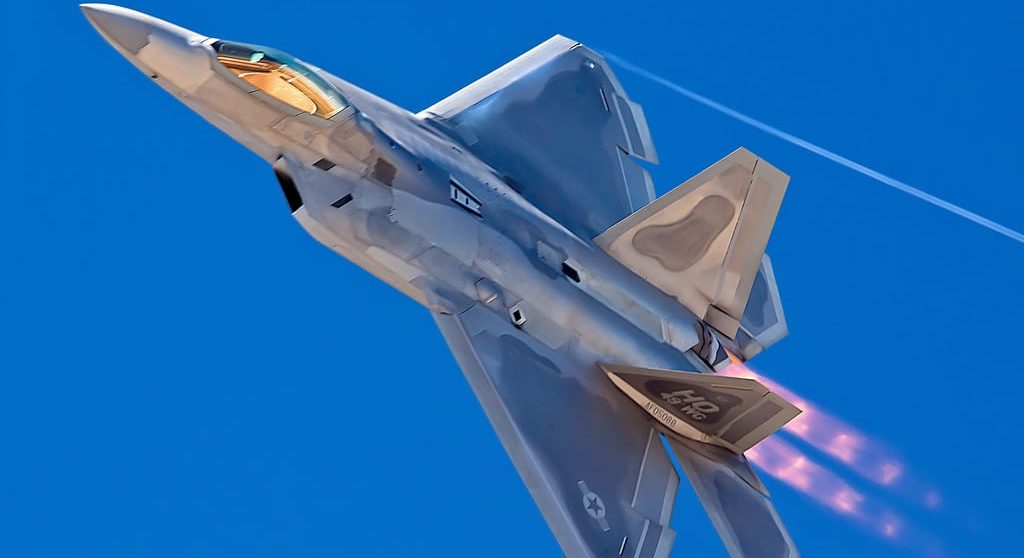This article by Miguel Ortiz originally appeared on We Are the Mighty
The night sky is an inky black and the soldiers on the ground barely give it a passing glance. Their radar scopes are clear; no enemies inbound. The first sign that they receive of the American strike is the bombs falling on key strategic targets. Precision small-diameter bombs fall within inches of substations, radar sites, bunkers and anti-aircraft batteries.
The runway is also cratered by American bombs, but a few fighter planes manage to scramble into the air. Their pilots frantically check their radar for the unseen attackers—nothing. Suddenly, a volley of radar-guided AIM-120C AMRAAMs tears through the formation of fighters and erupts in an airborne spectacle of fire and twisted metal. The light from the fireball reflects the faintest glint of light on the visors of the American pilots as they turn their F-22 Raptors and FB-22 Strike Raptors for home.
Related: THE AIR FORCE’S ‘ARSENAL PLANE’ CONCEPT COULD PAIR F-35S WITH MISSILE-LADEN BOMBERS
Following the success of their F-22 Raptor stealth fighter, Lockheed Martin conducted a study in 2001 to determine the feasibility of developing a bomber platform from it. While the F-22 was designed as an air superiority fighter, it still maintained a degree of ground attack ability which Lockheed Martin hoped to exploit. If they could leverage the design and capabilities of the existing airframe, the cost of developing the new bomber would be significantly reduced.

Lockheed Martin developed a number of bomber concepts based on the F-22. Much of the Raptor’s avionics were retained and structural redesigns were focused on the fuselage and wings. An initial concept aimed to increase payload capacity by lengthening and widening the fuselage. However, this came with a penalty of a 25-30% increase in weight, materials and development costs. Instead, further concepts retained the same fuselage as the F-22 and bore elongated delta shape wings which allowed the concept bomber to carry more fuel and wing-mounted weapons.
With the new wings, the FB-22 Strike Raptor would have been able to carry up to 30-35 250-pound GBU-39 small diameter precision-guided bombs versus the F-22 Raptor’s payload capacity of eight such bombs. Unlike the F-22, the FB-22 would also have been able to carry bombs weighing up to 5,000 pounds. With weapons stored internally, the FB-22 would have had a maximum combat load of 15,000 pounds. With additional weapons mounted on the wings, the FB-22 would have lost some of its stealth capability but carry up to 30,000 pounds of weapons.
Its increased fuel capacity gave the Strike Raptor a range of 1,600 miles, nearly triple the F-22’s range of 600 miles, and could have been extended further with the addition of external fuel tanks. With this increased range, the FB-22 would have replaced the Air Force’s F-15E Strike Eagle and taken over some of the missions of the B-1 Lancer and B-2 Spirit bombers. In October 2002, Air Force Magazine reported that the FB-22 would have a combat effectiveness comparable to a B-2 Spirit armed with 2,000-pound bombs.
Related: 5 REASONS THE F-15 MIGHT BE THE BEST FIGHTER OF ALL TIME
In order to power this larger airframe, the F-22’s Pratt & Whitney F119-PW-100 engines would have been replaced with the Pratt & Whitney F135s which now power the Lockheed Martin F-35 Lightning II. Though early concepts featured no tailplanes, later concepts incorporated twin tailplanes. Additionally, since the Strike Raptor was meant to complement the F-22 with its ground-attack capability, dogfighting capability was not a priority and the thrust vectoring technology of the F-22 was omitted from the FB-22 concept. According to Flight International magazine, the FB-22 would have had a top speed of Mach 1.92.

In February 2003, Secretary of the Air Force James Roche reported to the House Armed Services Committee that he envisioned a strike force of 150 FB-22s, along with 60 B-1s, 21 B-2s, and 381 F-22s. Following this vision, in 2004, Lockheed Martin officially presented the FB-22 Strike Raptor concept to the Air Force. The concept met the Air Force requirement for a potential strategic bomber as an interim solution and would be operational by 2018.Additionally, since it was developed from the existing F-22, the cost of fully developing the FB-22 was estimated to be 75% less than the cost of developing an entirely new bomber. Air Force Magazine also reported that the FB-22’s stealth capabilities had been increased, adding externally mounted detachable and faceted weapons pods that could carry weapons on the wings without sacrificing stealth.

Unfortunately, following the 2006 Quadrennial Defense Review, the FB-22 Strike Raptor project was cancelled. The DoD wanted a bomber with greater range and the Strike Raptor would be developed no further. However, disappointed aviation fans still have the opportunity to fly the FB-22 and experience the “next-generation stealth bomber that could have been” in the popular hybrid arcade-style flight simulator Ace Combat. The FB-22 is featured as a flyable aircraft in Ace Combat 5, Ace Combat X, Ace Combat Joint Assault, and Ace Combat Infinity.





